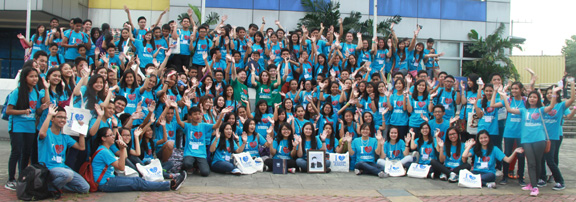
Top Photo: Students of San Francisco High School and Quezon City Science High School take a final group picture with the lecturers.
Bringing nuclear science and technology to Filipino students and teachers, the Philippine Nuclear Research Institute-Department of Science and Technology (PNRI-DOST) in cooperation with the Quezon City Division of City Schools of the Department of Education (DepEd) held the Seminar-Workshop on Nuclear Science and Technology for Secondary Schools from January 22-24 at the Quezon City Science Interactive Center.
The seminar-workshop serves as the first wave of an outreach program on nuclear science and technology for secondary schools implemented in the Philippines under the International Atomic Energy Agency (IAEA) Project RAS/0/065 on Supporting Sustainability and Networking of National Nuclear Institutions in Asia and the Pacific Region.
Ten (10) science teachers and 175 Grade 9 and Fourth Year high school students from Quezon City Science High School and San Francisco High School (the 2 pilot schools) were selected to participate in the seminar-workshop, where experts from the IAEA conducted lectures and hands-on experiments on the basics of nuclear science and its applications, particularly on radiation.
The students as well as the science teachers had the opportunity to monitor radiation in the environment through portable “Hakaru-kun” Mr. Gamma Radiation Monitors, while they also had the chance to “see” radiation through alpha tracks made in cloud chamber experiments using dry ice.
The lecturers from the IAEA also helped inspire more students to eventually engage in Science, Technology, Engineering and Mathematics (STEM) careers after graduating from high school to address the declining interest among students in these courses.
A seminar for the DepEd officials, science supervisors and science teachers was also held to discuss about the various approaches they use on presenting science and technology in the classroom, as well as on creating and sustaining their interest in these fields through various activities.
Beyond pen-and-paper worksheets and other academic exercises, the seminar-workshop also encouraged the students to showcase their talents to help in the promotion of science and technology, particularly nuclear S&T. The participants were divided into teams as they competed for the best presentations on what they learned during the lectures, which ranged from rhetorical speeches and poems to song compositions and dance numbers.
On the last day, 50 female students who were selected as members of the newly-formed Powerful Opportunities for Women Eager and Ready for Science Engineering and Technology (POWER SET) under the outreach program facilitated a science-themed sportsfest dubbed “Scilympics”, where teams composed of students from both schools competed in challenges that require the application of basic scientific principles.
During his visit to the Philippines the following week, IAEA Director General Yukiya Amano praised the enthusiasm and promising potential that the schools have shown in participating in the project.
“I congratulate you for your interest in science and technology, and particularly in nuclear science and technology, and I wish you all the success,” he said to the pilot schools on January 27.
“The future of your country will be based on science and technology, and the young generation is the hope for the future. I think your country is heading towards a very good direction.”
The Philippines was chosen as a pilot country for the project along with Indonesia, Malaysia and the United Arab Emirates in addressing what the IAEA recognizes as a very vital area in reaching out and developing the youth’s interest in nuclear science and technology by adopting the best practices in science education for secondary schools in the region. The IAEA also developed a compendium of resources and activities for use by high school teachers and students, which will be tailored to the flow of DepEd’s K to 12 Basic Education Curriculum.
The seminar-workshop is the first out of three planned throughout 2015 under the outreach program.












































